From Babylon to Bali: Part I of II / De Babilonia a Bali: Parte I de II
What they say about Bali is true—it changes you. Lo que dicen de Bali es cierto—te cambia.
Para leer la versión en español, desliza hasta abajo
From Babylon to Bali: Part I of II
On my phone, there’s a list of 56 countries I’ve visited. Number 51 is Indonesia, home of Bali, a picture-perfect island that has become a hotspot for cinematic shots thanks to its intricately-built temples, verdant layered rice fields, and surfer-friendly beaches. I came across the Island of the Gods (as it’s commonly known) when I was a teenager after spotting some mind-bending bamboo-built boutique hotels featured in a coffee-table book that depicted what seemed like one of the few remaining untouched locations in the world.
Years later I became more acquainted with the destination through my ex-wife, who traveled there at least twice a year to buy and import furniture to Colombia, where our eight-year-long relationship started. We never went to Bali together. At some point, we discussed moving there to save our marriage but in the end, she preferred Bogotá as her home base. A dealbreaker for someone with a gypsy heart. I once heard my Brazilian grandmother say that our ancestors were once Romani nomad itinerants who ended up in Portugal (after their predecessors migrated from Northern India into Central Europe, only to land in the Iberian peninsula before crossing the Atlantic). My life story begins in Bogotá, but I’ve always felt the need to escape from it.
Soon after we got divorced I booked my trip. I was living in Miami at the time, working for Univision, and used to hit the yoga studio every morning before heading to the office. Getting my Yoga Teacher Training certification was an excuse to go to Bali, one that bothered me deeply whenever people close to me asked if I was ready to embark on my Eat, Pray, Love journey. Did I fall into the spiritual economy or was I ready to have a spiritual breakthrough? Either way, knowing that I would finally get to be in Bali, would give me closure with my failed marriage.
I found a 22-day course north of Ubud, the yogic heart of the island.
But I almost didn’t make it.
Getting There
When I left Miami I knew I was going to take a few months off to backpack across Eastern Europe, but when the opportunity to deepen my yoga practice popped up, I expanded my trip to Southeast Asia. I had planned so I would fly from Bangkok to Bali, a short and affordable leg of the itinerary, but nature had other plans. Mount Agung, an active volcano and the highest point on Bali standing at 3,000 meters above sea level, was fuming so much that it ended up closing all the airspace traffic for a few days. The ash-spewing mountain is considered to be the most sacred on the island, the equivalent of Mount Meru, considered by Hindus, Jainists, and Buddhists as the source of the universe and the abode of the gods. And the locals were concerned they were pissed off.
After canceling my ticket twice, Denpasar Airport resumed its operations just one day before the start of my certification course. I managed to get there. My first impression of Bali was that it had similar weather to the tropical regions of Colombia. But this place had something different. People smiled more. Everything smelled of frangipani flowers. Or incense. Most roads were quite narrow, built to avoid interrupting the jungle too much. Foreigners wore workout clothes and drove scooters, swerving to avoid the grocery-snatching monkeys who stood on the sidewalks protecting their territory. There were rice paddies and palm trees everywhere. Restaurants served food fit to appear on social media. Yoga classes happened round the clock, except when there were ecstatic dance parties.
I spent the first night in Canggu—the hippest part of the island—at a high-end bed-and-breakfast. The house was, ample, beautifully built and decorated, and surprisingly affordable once I checked the exchange rate (I’m not sure how expensive Bali is these days, but in 2017, you could have a great meal for around $5 USD and stay in the hotel of your dreams for $30-40 USD per night). Once I dropped the oversized backpack in my room, I stepped outside onto the patio. There, something twisted and coiled on the grass: a baby cobra. “Naga!” yelled the staff member to whom I pointed the snake. In Balinese Hindu mythology, the cobra is revered as a protective entity, symbolizing both good and evil, embodying life's balance. It’s often thought they represent the spirit of Anantaboga, the world serpent representing the underworld and fertility, or Shiva, who protects those who encounter them by showing his control over dangerous creatures.
That night I headed to a local restaurant that was bustling with good-looking tourists; depending on the degree of their tan, you could tell how long they had been in Bali. The lobster-red faces gave away who were the newcomers, while the sunkissed bronze bodies were indicators of a lengthier stay. Most people were in their late twenties and early thirties, drinking beer and jamu (a local preparation involving a hefty dose of turmeric and ginger). They looked carefree and happy. It was contagious.
The Yoga Experience
I arrived at the yoga teacher's training at 10 am; I was one of the last students to make it there. The hotel that would be our home for the next three weeks was cozy and clean, surrounded by nature and with a direct view of Mount Agung, still spewing ashes into the sky. The future teachers were hanging out in the lobby where the staff was greeting the arrivals; it was then that I found out I would be the only man attending that course. The rest of the 25 participants were women. During the introductory session, it was clear that someone had to address the elephant in the room, and from then on, I was denominated as “the balance” (laying on me the impossible task of counterbalancing the feminine energy that reverberated in that space).
Classes started at 6 am, and because I like to take time to drink my coffee in the morning and head to the bathroom before stepping onto the mat, I got up at 4:30 am every day for the duration of the course. We observed silence for most of the morning when we practiced asanas and flows for two hours before opening our notebooks to learn about Patanjali’s Yoga Sutras, the importance of chakras and nadis in Ayurvedic medicine, anatomy, physiology, and the history of the practice before diving into deep meditations to close the day in a shala surrounded by lush rainforest. After the first week, my body started to give in. The pain in my legs forced me to chug aspirins at night, just so I could keep going. I began to find the lessons to be boring. I remembered the hipsters in Canggu having fun. I pictured myself surfing.
Halfway through week two, I was ready to quit and head to the beach. I was done with yoga. I wanted to go to bed at 4:30 am after a night out, not wake up at that time to touch my toes. Perhaps I’m a quitter or perhaps I get bored of things too soon, but it didn’t feel right for me to be there. If it weren’t for Penelope, a French-American who convinced me to finish the course (she’s still a good friend), I would’ve ditched the long asanas for big waves.
It was during a communal mantra repetition towards the end of the course that I understood everything: we were reciting the Gayatri mantra in repetition, to learn it by memory. I have a very deep voice that I drop even lower when I pretend to sing. We chanted for what felt like hours. Something felt off. Out of tune. A different vibration. I stopped. The rest of the group, all female, proceeded. Suddenly, all their voices came together to create what sounded like the voice of a Devas, a benevolent supernatural being of light in Hindu mythology.
That day was the first time I cried my first-ever happy tears. I was absorbed in an emotional rush. That angelical voice pierced my third eye/pituitary gland and sent a rush of energy/hormones across my spirit/body. A cessation of time and space. Ego dissolution. Something cracked open inside of me, allowing ananda—pure awareness, supreme ecstasy, ultimate bliss. Enlightenment. I had surrendered. I wasn’t concerned about the past or the future. I was untroubled. I let go of control. I took the backseat and enjoyed the ride. From that day on, nothing bothered me. I walked with a light heart, a peaceful gaze, and a slight grin.
But it didn’t last for long.
••
Don’t forget to subscribe to read part II of this chronicle. Leave any questions in the comments section. Like and share these posts with others who appreciate writing.
••
De Babilonia a Bali: Parte I de II
En mi teléfono tengo una lista de 56 países que he visitado. El número 51 es Indonesia, el hogar de Bali, una isla perfecta que se ha convertido en el lugar para tomas cinematográficas gracias a sus templos maravillosamente construidos, campos de arroz gigantescos colgando en capas verdes, y playas amigables para los surfistas. La primera vez que me topé con la Isla de los Dioses (como se le conoce comúnmente) fue en un libro que mostraba unos increíbles hoteles boutique construidos con bambú, inmersos en lo que parecía ser uno de los pocos lugares vírgenes que quedaban en el mundo.
Luego conocí más sobre el destino a través de mi exesposa, quien viajaba allí al menos dos veces al año para comprar e importar muebles a Colombia, donde comenzó nuestra relación de ocho años. Nunca fuimos juntos a Bali. En algún momento, conversamos sobre mudarnos allí para salvar nuestro matrimonio, pero al final, ella prefirió Bogotá como su base de operaciones. Un factor decisivo para alguien con corazón gitano como yo. Una vez escuché a mi abuela brasileña decir que nuestros antepasados eran itinerantes nómadas romaníes que terminaron en Portugal (después de que sus predecesores emigraran del norte de la India a Europa central, solo para aterrizar en la península ibérica antes de cruzar el Atlántico). La historia de mi vida comienza en Bogotá, pero siempre he sentido la necesidad de escapar de la ciudad.
Poco después de divorciarnos reservé mi viaje. En ese momento vivía en Miami, trabajaba para Univision y solía ir al estudio de yoga todas las mañanas antes de llegar a la oficina. Obtener mi certificación de Yoga Teacher Training fue una excusa para ir a Bali, una que de alguna forma me incomodaba, sobe todo cuando gente cercana me felicitaba por estar embarcándome en mi momento Eat, Pray, Love. ¿Había caído presa de la economía espiritual? ¿O estaba listo para tener un avance espiritual? De cualquier manera, saber que finalmente llegaría a estar en Bali, me serviría para dar cierre a mi matrimonio fallido.
Encontré un curso de 22 días al norte de Ubud, el corazón yóguico de la isla.
Pero casi no logro llegar.
El camino hasta allí
Cuando me fui de Miami sabía que me iba a tomar unos meses de viaje de mochilero por Europa del Este, pero cuando apareció la oportunidad de profundizar mi práctica de yoga, extendí mi viaje al sudeste asiático. Había planeado volar de Bangkok a Bali, un tramo corto y asequible del itinerario, pero la naturaleza tenía otros planes. El Monte Agung, un volcán activo y el punto más alto de Bali a 3.000 metros sobre el nivel del mar, echaba tanto humo que acabó cerrando todo el tráfico del espacio aéreo durante unos días. La montaña que escupía cenizas se considera la más sagrada de la isla, el equivalente del monte Meru, considerado por hindúes, jainistas y budistas como la fuente del universo y la morada de los dioses. Y a los lugareños les preocupaba que estuvieran enojados.
Después de cancelar mi boleto dos veces, el aeropuerto de Denpasar reanudó sus operaciones solo un día antes del inicio de mi curso de certificación. Logré llegar. Mi primera impresión de Bali fue que tenía un clima similar al de las regiones tropicales de Colombia. Pero este sitio tenía algo diferente. La gente sonreía más. Todo olía a flores de frangipani. O incienso. La mayoría de los caminos eran bastante angostos, construidos para no interrumpir demasiado la jungla. Los extranjeros vestían ropa deportiva y conducían scooters, virando bruscamente para evitar a los monos que robaban compras y comestibles de las bolsas de transeúntes que pasaban por su territorio. Había arrozales y palmeras por todas partes. Los restaurantes servían comida tan bonita lista para aperecer en las redes sociales. Las clases de yoga se daban las 24 horas del día, excepto cuando había fiestas de ecstatic dance.
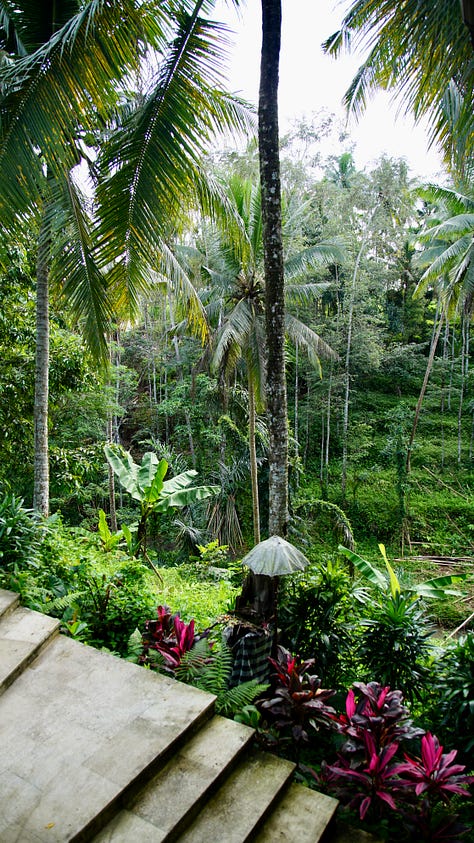
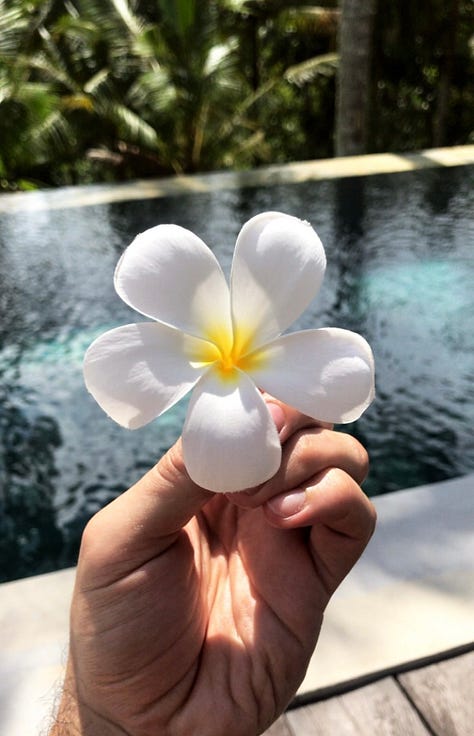
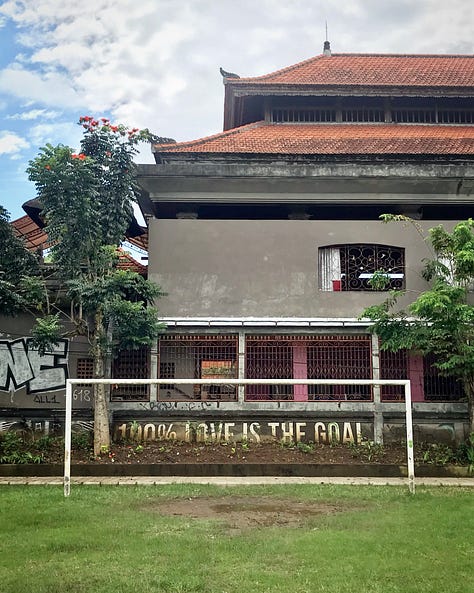
Pasé la primera noche en Canggu, la parte más de trendy de la isla, en un bed and breakfast de lujo. La casa era amplia, bellamente construida y decorada, y sorprendentemente asequible una vez que verifiqué el tipo de cambio (no estoy seguro de lo caro que es Bali en estos días, pero en 2017, podrías tener una excelente comida por alrededor de $5 USD y quédarte en el hotel de tus sueños por $30-40 USD por noche). Una vez que dejé mi mochila en la habitación, salí al patio. Allí, algo se retorcía sobre la hierba: una cobra bebé. “Naga!” gritó el miembro del personal a quien señalé la serpiente. En la mitología hindú balinesa, la cobra es reverenciada como una entidad protectora, que simboliza tanto el bien como el mal, encarnando el equilibrio de la vida. A menudo se piensa que representan el espíritu de Anantaboga, la serpiente del mundo del inframundo y la fertilidad, o Shiva, que protege a quienes se encuentran con las víboras, demostrando su control sobre criaturas peligrosas.
Esa noche me dirigí a un restaurante local que estaba repleto de turistas que parecían salidos de una revista; según el grado de su bronceado, se podía decir cuánto tiempo habían estado en Bali. Los rostros rojos como langostas delataban quiénes eran los recién llegados, mientras que los cuerpos bronceados, bañados por el sol, eran indicadores de una estancia más prolongada. La mayoría de la gente tenía entre veinte y treinta años, bebían cerveza y jamu (una preparación local que implica una fuerte dosis de cúrcuma y jengibre). Parecían despreocupados y felices. Era contagioso.
La experiencia del yoga
Llegué a la formación de profesores de yoga a las 10 de la mañana; Fui uno de los últimos estudiantes en arribar. El hotel que sería nuestro hogar durante las próximas tres semanas era acogedor y limpio, rodeado de naturaleza y con vista directade Monte Agung, que todavía arrojaba cenizas al cielo. Los futuros maestros estaban pasando el rato en el vestíbulo donde el personal saludaba a quienes iban llegando; fue entonces cuando supe que sería el único hombre que asistiría a ese curso. El resto de los 25 participantes eran mujeres. Durante la sesión introductoria, estaba claro que había un elefante en la habitación y, a partir de ese momento, yo fui denominado como “el equilibrio” (dándome la responsabilidad imposible de balancear la energía femenina que reverberaba en ese espacio).
Las clases comenzaban a las 6 a. m., y como me gusta tomarme un tiempo para tomar mi café por la mañana e ir al baño antes de pisar el mat, me levanté a las 4:30 a. m. todos los días durante la duración del curso. Observamos silencio durante la mayor parte de la mañana cuando practicamos asanas y secuencias durante dos horas antes de abrir nuestros cuadernos para aprender sobre los Yoga Sutras de Patanjali, la importancia de los chakras y nadis en la medicina ayurvédica, anatomía, fisiología y la historia de una de las filosofías más antiguas edel mundo antes de sumergirnos en meditaciones profundas. para cerrar el día en un shala rodeado de frondosa selva tropical. Después de la primera semana, mi cuerpo comenzó a ceder. El dolor en las piernas me obligaba a tomar aspirinas por la noche, solo para poder seguir adelante. Empecé a encontrar las lecciones aburridas. Recordé a los hipsters de Canggu divirtiéndose. Me imaginé surfeando.
A la mitad de la segunda semana, estaba listo para dejar el curso e ir a la playa. Me había cansado del yoga. Quería acostarme a las 4:30 am después de una noche de fiesta, no despertarme a esa hora para tocarme los dedos de los pies. Tal vez soy tengo alma de desertor o tal vez me aburro de las cosas demasiado rápido, pero no se sentía bien para mí estar allí. Si no fuera por Penélope, una franco-estadounidense que me convenció de terminar el curso (hoy sigue siendo una buena amiga), habría abandonado las asanas largas por olas grandes.
Durante una sesión en la que repetimos mantras en grupo logré entender todo: estábamos recitando el mantra Gayatri en grupo para memorizarlo. Tengo una voz muy profunda que bajo aún más cuando pretendo cantar. Cantamos durante lo que parecieron horas. Algo se sintió mal. Fuera de tono. Una vibración diferente. Me detuve. El resto del grupo, todas mujeres, procedió mientras yo escuchaba. De repente, todas sus voces se unieron para crear lo que sonaba como la voz de un Devas, un benévolo ser sobrenatural de luz de la mitología hindú.
Ese día fue la primera vez que lloré lágrimas de felicidad. Estaba sobrecogido de emoción. La voz angelical perforó mi tercer ojo/glándula pituitaria y envió una ráfaga de energía/hormonas a través de mi espíritu/cuerpo. Hubo una cesación del tiempo y del espacio. Disolución del ego. Algo se abrió dentro de mí, permitiendo que entrara la ananda: conciencia pura, éxtasis supremo, felicidad suprema. Iluminación. me había rendido. Había logrado la tranquilidad absoluta; no me preocupaba el pasado ni el presente. Solté el control de mi vida. Tomé el asiento trasero y disfruté el viaje. A partir de ese día, nada me molestaría. Caminé con un corazón ligero, una mirada pacífica y una leve sonrisa.
Pero no duró mucho.
••
No olvides suscribirte para leer la parte II de esta crónica. Deja cualquier duda en la sección de comentarios. Dale me gusta y comparte esta publicación con otras personas que aprecian la escritura.






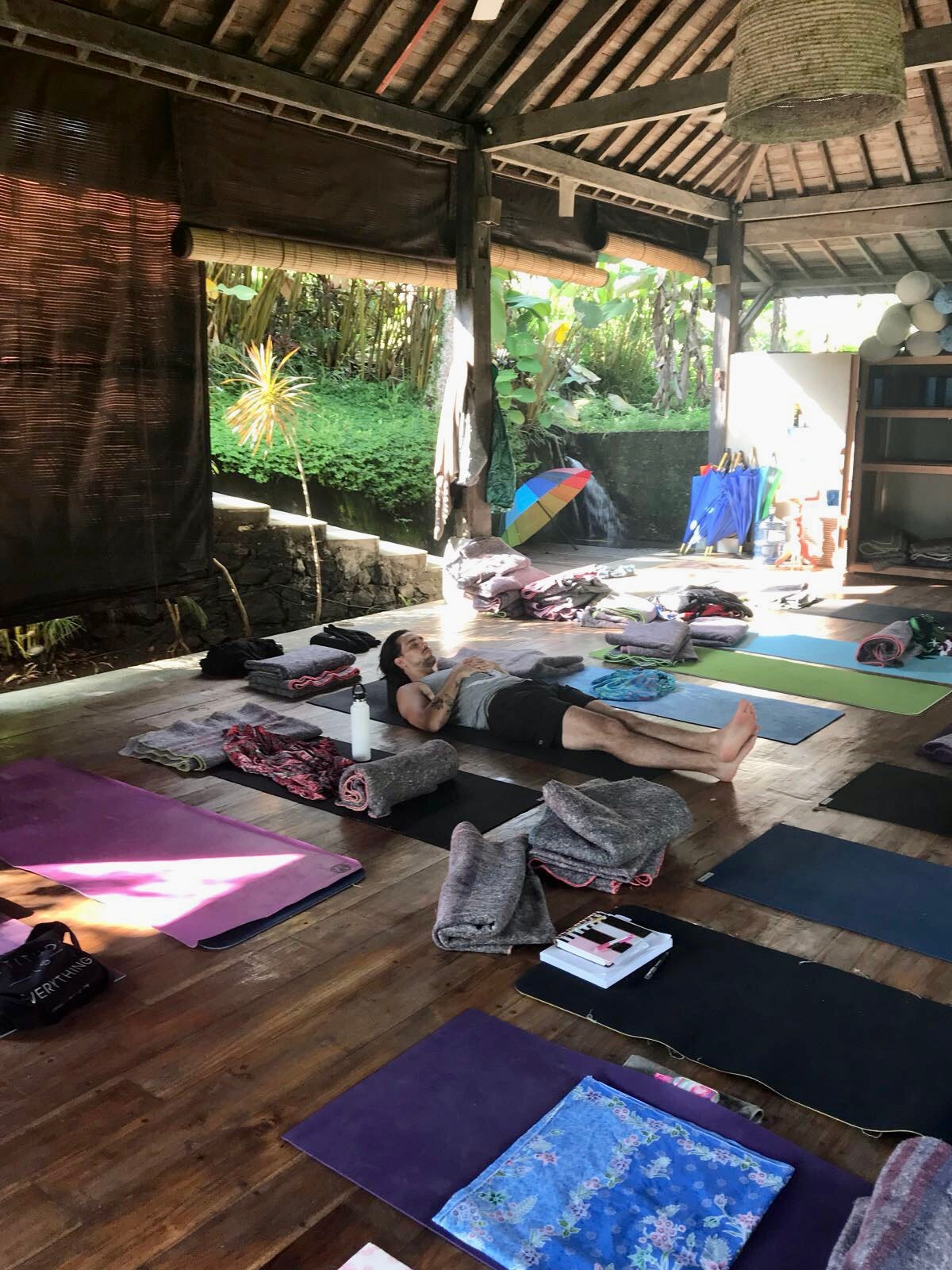

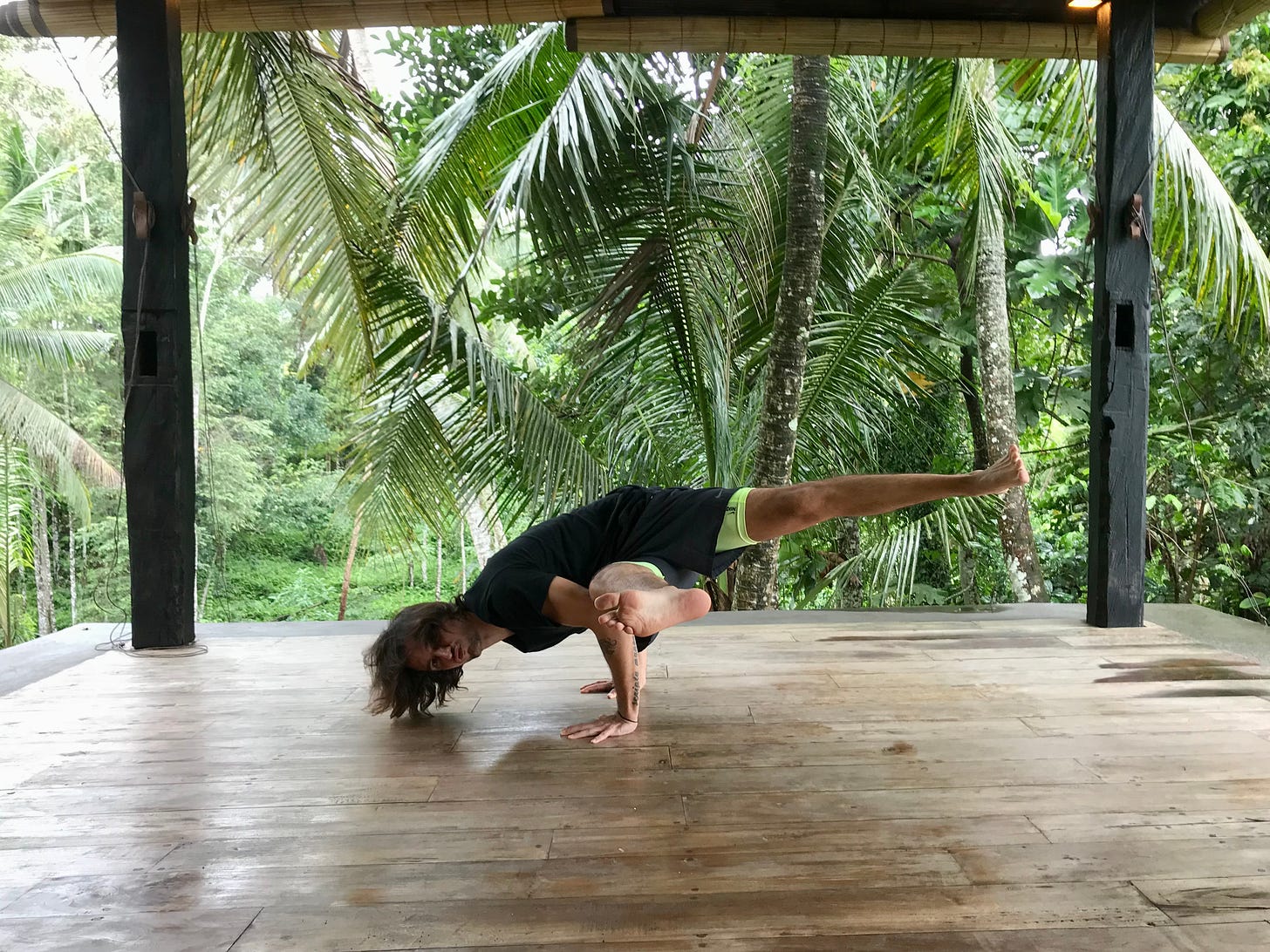
Que lindo— re senti lo que escribiste! 🤍
Se me lleno del corazón de ganas de volver!
Siempre he querido ir a Bali, está en mi lista de países que me gustaría visitar.
Disfruté leerte, gracias por compartirlo 😉